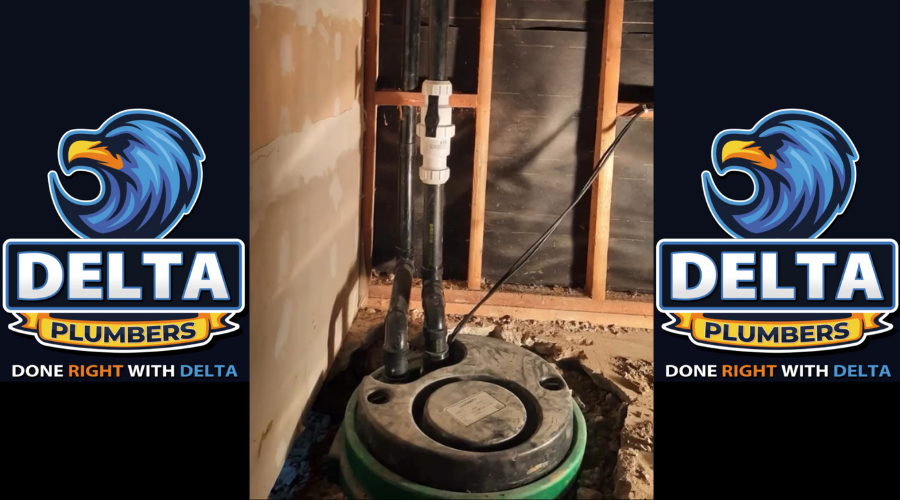A well-maintained sump pump is essential for protecting your home from water damage and flooding, especially during heavy rains or snowmelt. Proper maintenance not only extends the life of your sump pump but also ensures that it functions efficiently when you need it the most. In this comprehensive guide, we’ll explore how to maintain your sump pump and prevent flooding, focusing on key aspects like preventing sump pump flooding, essential maintenance tasks, conserving water, and understanding the life expectancy of a sump pump.

Picture Source – Delta Plumbers
How to Prevent Sump Pump Flooding
Preventing sump pump flooding starts with understanding the common causes of failure and taking proactive measures to avoid them. Flooding can result from a variety of issues, including power outages, mechanical failure, clogged discharge lines, and overwhelming water flow. Here are some steps you can take to prevent sump pump flooding:
1. Install a Backup Power Source
Sump pumps rely on electricity to operate, so a power outage during a storm can render your pump useless. To prevent this, install a battery backup or a generator to ensure your sump pump remains operational during a power outage. A battery backup can keep your sump pump running for several hours, while a generator can provide continuous power until the main electricity is restored.
2. Regularly Test Your Sump Pump
Testing your sump pump regularly is crucial for ensuring it functions correctly when needed. To test your sump pump, pour water into the sump pit until the float switch activates the pump. If the pump doesn’t turn on or fails to remove the water, it’s time for a thorough inspection or professional maintenance.
3. Clear the Discharge Line
The discharge line carries water from the sump pit to the outside of your home. If this line becomes clogged with debris or frozen in winter, the water will back up into your basement. Make sure the discharge line is clear and has an appropriate slope to prevent water from flowing back into the pit. Installing a sump pump discharge line protector can also help prevent clogs.
4. Install a Secondary Sump Pump
If you live in an area prone to heavy rainfall or have a high-water table, a single sump pump may not be sufficient. Installing a secondary sump pump provides an additional layer of protection. The secondary pump can act as a backup if the primary pump fails or can be set to activate at a higher water level to handle an increased water load.
5. Maintain the Check Valve
A check valve is installed on the discharge line to prevent water from flowing back into the sump pit. If the check valve is faulty or missing, water can flow back into the pit, causing the pump to cycle frequently and eventually fail. Ensure the check valve is installed correctly and in good working condition.
Also Read: Signs You Need to Replace Your Plumbing Pipes

Picture Source – Delta Plumbers
What Maintenance Should I Do on My Sump Pump?
Regular maintenance is key to ensuring your sump pump operates efficiently and lasts as long as possible. Here are some essential maintenance tasks you should perform on your sump pump:
1. Clean the Sump Pit
Over time, dirt, debris, and sediment can accumulate in the sump pit, potentially clogging the pump and reducing its efficiency. Regularly cleaning the sump pit helps prevent these issues. To clean the sump pit, first, disconnect the pump from the power source, remove it from the pit, and then use a shop vac or a bucket to remove any debris from the pit.
2. Inspect and Clean the Pump and Components
After removing the pump from the pit, inspect it for any signs of wear, corrosion, or damage. Pay special attention to the float switch, impeller, and inlet screen. Clean these components with water and a soft brush to remove any debris that could obstruct their operation. If any parts are damaged or excessively worn, consider replacing them.
3. Check the Power Source and Connections
Ensure the sump pump is connected to a reliable power source and that all electrical connections are secure. If your pump is connected to a GFCI outlet, test the outlet regularly to ensure it’s functioning correctly. A tripped GFCI could prevent your sump pump from operating during a storm.
4. Test the Float Switch
The float switch is a critical component that activates the pump when the water level in the sump pit rises. To test the float switch, pour water into the pit until the float rises and activates the pump. If the float switch doesn’t move freely or fails to activate the pump, it may need to be cleaned, adjusted, or replaced.
5. Inspect the Discharge Line
Regularly inspect the discharge line for signs of clogs, leaks, or damage. Ensure the line is sloped away from your home and that the outlet is clear of debris. In cold climates, consider insulating the discharge line to prevent freezing.
6. Replace the Battery in the Backup System
If your sump pump is equipped with a battery backup, regularly check the battery’s charge level and replace it as needed. Most batteries last 3-5 years, but it’s important to follow the manufacturer’s recommendations for replacement.
7. Schedule Annual Professional Inspections
While regular DIY maintenance is essential, scheduling an annual inspection with a professional plumber can help identify potential issues before they become major problems. A professional can thoroughly inspect your sump pump, check for wear and tear, and perform any necessary repairs or replacements.
Also Read: Right Plumber for Your Needs: How to Choose Best

Picture Source – Delta Plumbers
What is the Normal Life Expectancy of a Sump Pump?
Understanding the life expectancy of a sump pump is important for planning maintenance, budgeting for replacements, and avoiding unexpected failures. Here’s what you need to know about the typical lifespan of a sump pump:
1. Average Life Expectancy
The average life expectancy of a sump pump is typically between 7 to 10 years. However, this can vary depending on factors like the pump’s quality, usage frequency, and maintenance. High-quality pumps that are well-maintained can last up to 15 years or more, while cheaper models may need replacement after just a few years.
2. Factors Affecting Sump Pump Lifespan
Several factors can influence the lifespan of a sump pump:
- Frequency of Use: Pumps that run frequently, especially during rainy seasons, may wear out more quickly than those that are used less often.
- Water Quality: Pumps that handle dirty or debris-laden water may experience more wear and tear, reducing their lifespan. Installing a filter or regularly cleaning the sump pit can help mitigate this.
- Power Source: Pumps that experience frequent power surges or are connected to unreliable power sources may have a shorter lifespan. Using a battery backup or surge protector can help protect the pump’s electronics.
- Maintenance: Regular maintenance, including cleaning the pump, inspecting components, and testing the system, can significantly extend the life of your sump pump.
3. Signs Your Sump Pump Needs Replacement
Even with regular maintenance, sump pumps will eventually need to be replaced. Here are some signs that your sump pump may be nearing the end of its life:
- Frequent Cycling: If your pump cycles on and off more frequently than usual, it may indicate that the float switch or check valve is failing.
- Strange Noises: Unusual noises like grinding, rattling, or squealing can indicate that the pump’s motor or impeller is worn out.
- Reduced Performance: If your pump is struggling to remove water from the pit or takes longer than usual to do so, it may be losing efficiency.
- Visible Wear and Tear: Inspect the pump for signs of corrosion, cracks, or other physical damage. If the pump appears worn or damaged, it may be time for a replacement.
4. Budgeting for Replacement
Budget for a sump pump replacement every 7 to 10 years to avoid being caught off guard by a failure. A new sump pump typically costs between $150 and $500, depending on the type and quality. While professional installation may increase the cost, it’s a worthwhile investment to ensure proper installation and reliable function.
Also Read: Water Heater Installation and Maintenance Tips

Picture Source – Delta Plumbers
How Often Do Sump Pumps Need to Be Cleaned?
Regular cleaning is essential for maintaining the efficiency and longevity of your sump pump. Here’s what you need to know about how often sump pumps should be cleaned and the best practices for doing so:
1. Recommended Cleaning Frequency
It’s recommended to clean your sump pump at least once a year. However, if your pump runs frequently or handles a lot of debris, more frequent cleaning may be necessary. Cleaning your sump pump before the rainy season or after heavy storms can help ensure it’s ready to handle increased water flow.
2. Steps for Cleaning Your Sump Pump
Cleaning your sump pump is a relatively simple process that you can do yourself or hire a professional to perform. Here’s a step-by-step guide:
- Disconnect the Power: Before cleaning, always disconnect the pump from the power source to avoid electrical shocks.
- Remove the Pump from the Pit: Carefully lift the pump out of the sump pit. Be prepared for some water to spill, so have towels or a bucket handy.
- Clean the Pump and Components: Use a hose or bucket of water to rinse off dirt and debris from the pump’s exterior. Pay special attention to the inlet screen, impeller, and float switch, as these components are prone to clogging. Use a soft brush to remove any stubborn debris.
- Inspect the Discharge Line: While the pump is out of the pit, inspect the discharge line for clogs or damage. Clear any blockages and ensure the line is securely connected.
- Clean the Sump Pit: Use a shop vac or bucket to remove any debris, sediment, or standing water from the sump pit. A clean pit helps prevent clogs and reduces the risk of pump failure.
- Reinstall the Pump: Once the pump and pit are clean, carefully lower the pump back into the pit and reconnect the power. Test the pump by pouring water into the pit to ensure it’s working correctly.
3. Benefits of Regular Cleaning
Regularly cleaning your sump pump offers several benefits:
- Improved Efficiency: A clean pump operates more efficiently, reducing energy consumption and wear on the motor.
- Extended Lifespan: Removing debris and preventing clogs can significantly extend the life of your sump pump.
- Reduced Risk of Failure: Regular cleaning helps identify potential issues before they become major problems, reducing the risk of unexpected pump failure during a storm.
- Better Water Quality: A clean sump pit and pump reduce the chances of debris and contaminants entering your home’s drainage system, leading to better water quality.
4. When to Call a Professional
While regular cleaning can be done as a DIY project, there are times when it’s best to call a professional. If you’re unsure about how to clean your sump pump, notice any signs of damage, or experience frequent pump failures, a professional plumber can provide expert maintenance and repair services.
Conclusion
Maintaining your sump pump is essential for preventing flooding and protecting your home from water damage. By understanding how to prevent sump pump flooding, performing regular maintenance, and knowing when to replace your pump, you can ensure your sump pump operates efficiently for years to come. Incorporate these tips into your home maintenance routine to better prepare for heavy rains, snowmelt, and unexpected water flow.
Delta Plumbers is here to assist with all your sump pump maintenance and repair needs. Our team of experienced professionals can help you keep your sump pump in top condition, ensuring your home remains dry and safe. Contact us today to schedule a maintenance appointment or to learn more about our services.









